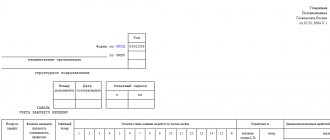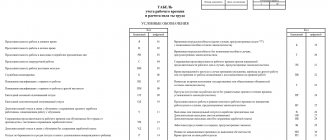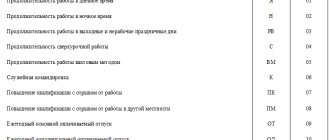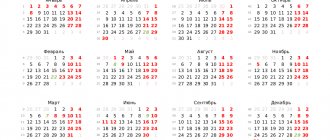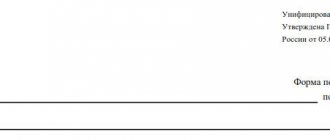Each organization must keep daily records of the presence of employees at their workplaces; for this, the HR department uses a unified form of time sheet in the T-13 form. It allows you to record their presence, lateness and absence, the reasons for which can arise for various reasons, both valid and not valid. Based on the data from the timesheet at the end of the month, the accounting department calculates the wages of employees, especially for those employees whose wages are based on the time they are present at the workplace.
Who fills out the time sheet?
The form is filled out either by an employee of the HR department, or by the head of a structural unit, or by a timekeeper specially hired for this function. Based on the information entered into it, the accounting department specialists calculate wages and other payments to the organization’s employees. In fact, the time sheet is one of the most important accounting documents. And while small companies can easily do without it, large enterprises are required to keep such timesheets.
Depending on the personnel records system adopted at the enterprise, a time sheet can be generated either one for all employees of the organization, or maintained separately in each department.
The timesheet is a regular document, that is, a new copy must be compiled every month, so the serial number of the timesheet will be equal to the serial number of the month in which it was created. The timesheet preparation period covers all days of the month.
You can fill out the timesheet either electronically or in writing. However, after entering all the necessary information, it will still have to be printed for the signatures of the responsible persons.
What programs are used to keep timesheets?
To fill out timesheets automatically, you must either buy a program (but you will still have to enter information into it manually), or install a set of software and hardware that will automatically collect, store and process information about the presence of workers on site, their hours arrival and departure, periods of work and rest of employees, etc.
Such systems have functions for analyzing the information they receive, and therefore are very convenient and save a lot of time for personnel officers and accountants. Employers are also delighted, because at any moment they can see where Petrov’s employee is, what he’s doing, when he left yesterday, etc. However, in addition to all their advantages, these systems have one significant drawback - the implementation of such programs is very expensive.
Form T-13. Shape Features
Let's start with the T-13 form, which is now used much more often for maintaining time sheets.
The unified form T-13 or electronic time sheet is well known to HR department employees. This is not the only way, but it is definitely the most standard way to account for hours worked. If you keep records manually, you should use Form T-12.
Timesheets are a common tool for tracking employee attendance. Form T-13 allows you to record in detail the reasons for absence from work, including student leave during the session, advanced training and several types of disability leave. The period for which the document is completed may be less than 31 days.
A completed T-13 is the basis for calculating wages.
Vacation notes
Before marking vacation on your time sheet, it is important to consider the following points:
- what type of leave to indicate;
- vacation period - from what date to what date the employee rests;
- what method is used to fill out the timesheet - continuous or only deviations are recorded?
Different types of leave are indicated by the following abbreviations:
| FROM | Another paid vacation |
| OD | Additional paid |
| BEFORE | Administrative (without saving salary) |
| U | Educational with salary retention |
| UV | On-the-job training (shortened day) |
| UD | Educational without saving salary |
| R | For pregnancy and childbirth |
| coolant | Child care up to 3 years old |
| OZ | Without saving the salary in cases provided for by law |
| DB | Additional without saving salary |
When using both methods of filling out a timesheet, a vacation symbol is affixed for each day the employee is absent. It’s just that when using the continuous method, the remaining days are filled with turnouts (conditional code “I”), and when using the deviation accounting method, they remain empty.
Format for filling out a working time sheet in T-13
Unlike arbitrary tables of similar content, T-13 contains data about the enterprise, including the form of ownership and OKPO. The document number is entered in accordance with internal requirements for maintaining timesheets.
The department name is also shown at the top. It must be remembered that the head of this department (even if filling out the time sheet is not his or her responsibility) must sign the completed form.
The order of employees is determined by the decision of the person in charge. Most often, alphabetical sorting is found, as in our example, but the option of arranging by personnel number is possible (column 3).
In column 4 we put marks by day:
I - (appearance) working day, B - day off, FROM - vacation, RP - attendance on a day off (working out), K - business trip, PC - advanced training, U - study leave with a call from an educational institution, B - sick leave with sick leave sheet, T - unpaid sick leave without sick leave.
Under the I mark we put the number of hours worked that day. In column 5 we summarize the number of I in the line and the number of hours. We get 4 values for 2 halves of the month. In column 6 we sum up the values and get the final figure for the work for the month.
The number of hours for B, OT, K, B and other cases is not indicated in the fourth column. For this there are columns 10-13.
Accounting for sick leave, vacations or absences for other reasons
Designation codes may be different (for example, numeric). There is no specific format required by law.
The notation X shows that we are not taking this day into account: for convenience, the month is divided into two lines with unequal values. For months with 30 days (for example, November, the column will look like this (for convenience, the “non-existent” 31st number is highlighted in red):
T-13 for November
By analogy, T-13 is filled out for visits in February.
Columns 7-9 indicate the payment code, number of days and type of charges. Our example uses the following codes:
- 2000 - Common workday,
- 2300 – sick leave (disability benefit),
- 2012 - vacation.
Alternative solution
Some enterprises approve a slightly simplified version of the time sheet without detailing the reasons for omissions. Column 4 indicates only 2 codes:
- I am a working day
- N - unworked day.
This method may be inconvenient because it does not record sick leave.
Special cases
- How to fill out T-13 for employees participating in conferences and other training events?
- Can code I have a value of more than 8 hours?
- What is the difference between report cards T-12 and T-13?
Depends on the position of the enterprise. These days can be counted as working days (I), or as advanced training (PC). Pay rates may also vary.
Yes. Maybe if there is a special order about extended working hours. Overtime hours can be marked with the symbol C.
The first is a manual attendance form. The second is electronic. Many accounting departments today have switched to T-13, since it can be automatically collected using a special program.
Non-standard situations
[ads-pc-4] [ads-mob-4]
Leave without pay
According to the law, the following types of such leave can be distinguished:
- For family reasons – “BEFORE”
- Leave without pay, provided in accordance with the Labor Code of the Russian Federation, for example, on the occasion of a wedding - “OZ”
- Based on a decision under a collective agreement or an industry decision - “DB”
If there are holidays during your vacation
If there are holidays during the allotted vacation, in accordance with the production calendar for the current year, such days are marked with code “B”. So, for example, if an employee went on vacation from June 9 to June 16, and during this period there is a holiday on June 12, then instead of the code (OT), you need to write code “B”. This day is not included in the paid vacation period.
Illness during annual leave
If during vacation an employee suffered an illness and provided sick leave as confirmation, then instead of the “OT” code, you must write down the “B” code, in accordance with the sick leave. In this case, the leave will be extended for the duration of the illness.
Form T-12
First of all, as in any other personnel records document, you first need to enter the details of the organization into the timesheet: its full name indicating the OKPO code (must be taken from the registration documents), organizational and legal status (IP, LLC, CJSC, JSC), as well as the structural unit (department) for which this timesheet is maintained (if necessary).
Then you need to enter the document number for internal document flow in the appropriate column, and also indicate the reporting period that this timesheet takes into account.
Numerical and alphabetic codes in the time sheet
This part of the timesheet includes the alphabetic and numeric codes used to fill out the necessary information for employees, as well as their decoding. They must be entered in the main part of the timesheet in order to briefly and clearly reflect the amount of time actually spent by one or another employee at the workplace, as well as the reasons for his absence from work. If HR department specialists need to enter some additional codes into this timesheet form, they can be developed independently and entered into this table.
General concepts
The time sheet plays an important role in the operation of the enterprise, from recording employee attendance at the workplace to calculating their wages. Each event has its own special code, which can reflect the time of the working day, illness, business trip, vacation, including lateness and absence of the employee from work. In addition, this document allows you to track the norms of the working week and make certain adjustments to the work process.
Thus, based on the report card data, the manager can make certain decisions on changing the employee’s work week if there is overtime; this can quite often occur with a flexible schedule or replacing a sick employee. Also, based on the report card data, you can make a decision both on bonuses and incentives for the employee, and on depreciation and imposition of penalties.
Please note that the first part of the timesheet, for the first half of the month, is submitted to the accounting department to calculate advance wages, and based on the fully completed timesheet, a full calculation of wages is made.
Working time recording in T-12
This section in the timesheet is the main one - it is where working time is kept track of. First, you need to enter the employee’s serial number in the first column of this section, then in the second - his full name (preferably his full name and patronymic to avoid confusion and errors). In the third column you need to insert the employee’s personnel number assigned to him during employment (it is individual and never repeated).
For each employee, the timesheet has two lines - they contain encrypted information about presence or absence at the workplace on each calendar day of the month. In addition, it is necessary to immediately indicate the reason for absence from work, if one has been established.
The reason is indicated in the top line opposite the employee’s full name, and in the bottom line the number of hours actually worked, and if the employee did not appear at the workplace, the bottom cell can be left empty.
The next step is to calculate the total number of hours and days actually worked for two-week periods, and at the end of the table - the result of the calculations for the month.
In this case, you should carefully monitor that the total number of calendar days in a month coincides with the amount of working days, weekends and holidays indicated for each employee.
It should be said that sometimes those responsible for filling out the time sheet only enter information that relates to the days when the employee was absent from the workplace. However, this option may lead to personnel and accounting errors, so it is not advisable to use it.
Accounting and taxes
Based on the data indicated in the table, the accounting department calculates wages and various benefits. This data also affects the payment of taxes. Let's pay attention to the main risks.
When passing tax audits, including income tax, the company must provide reliable data on the number of days and hours worked by each employee in order to confirm the correctness of the accruals. If violations are discovered, the amount of income tax indicated in the reports will be recognized as incorrect, which will entail the imposition of penalties.
When withholding personal income tax from an employee’s earnings, the organization, as a tax agent, must find out whether this person is a tax resident of the Russian Federation in order to use the correct tax rate in the calculation. The report card will be able to confirm the actual presence of the employee in the country. This feature should especially be taken into account by those employers who send employees on business trips to Belarus or Kazakhstan, because when crossing these borders, no marks are made in the citizen’s passport. If a dispute arises, the company will be able to prove that it applied the correct rate, withheld and charged personal income tax in full.
Correctly filling out the timesheet guarantees the company the ability of the Social Insurance Fund to count expenses on sick leave, because it is impossible to officially confirm the number of days worked, which are extremely important when calculating these amounts.
